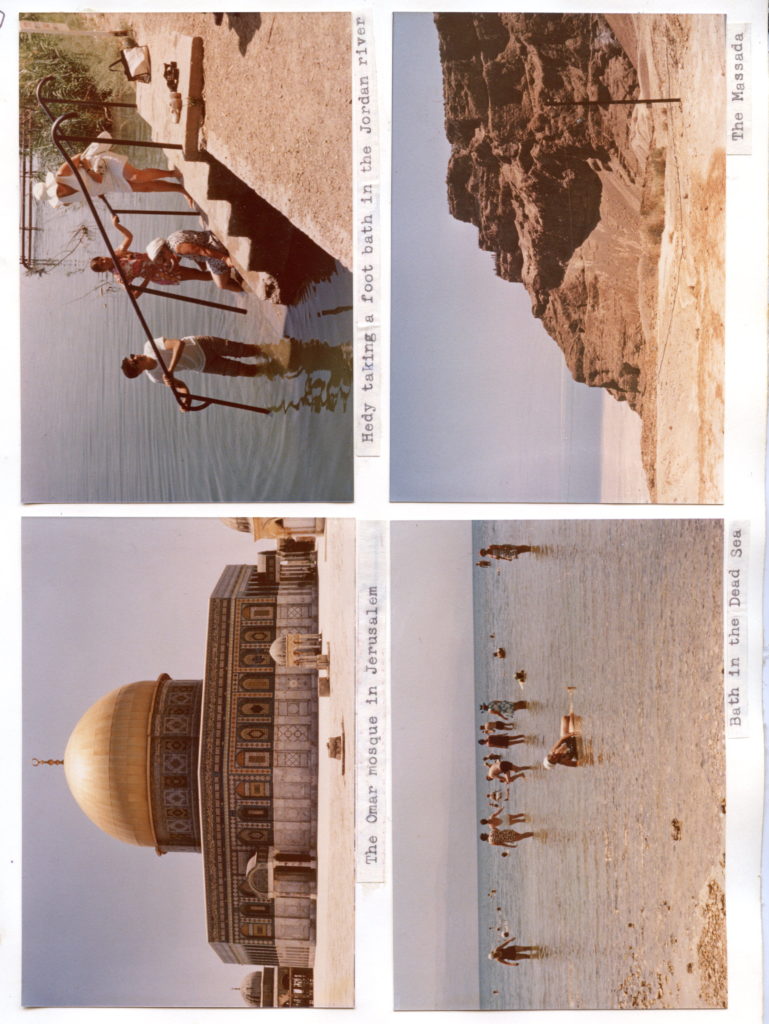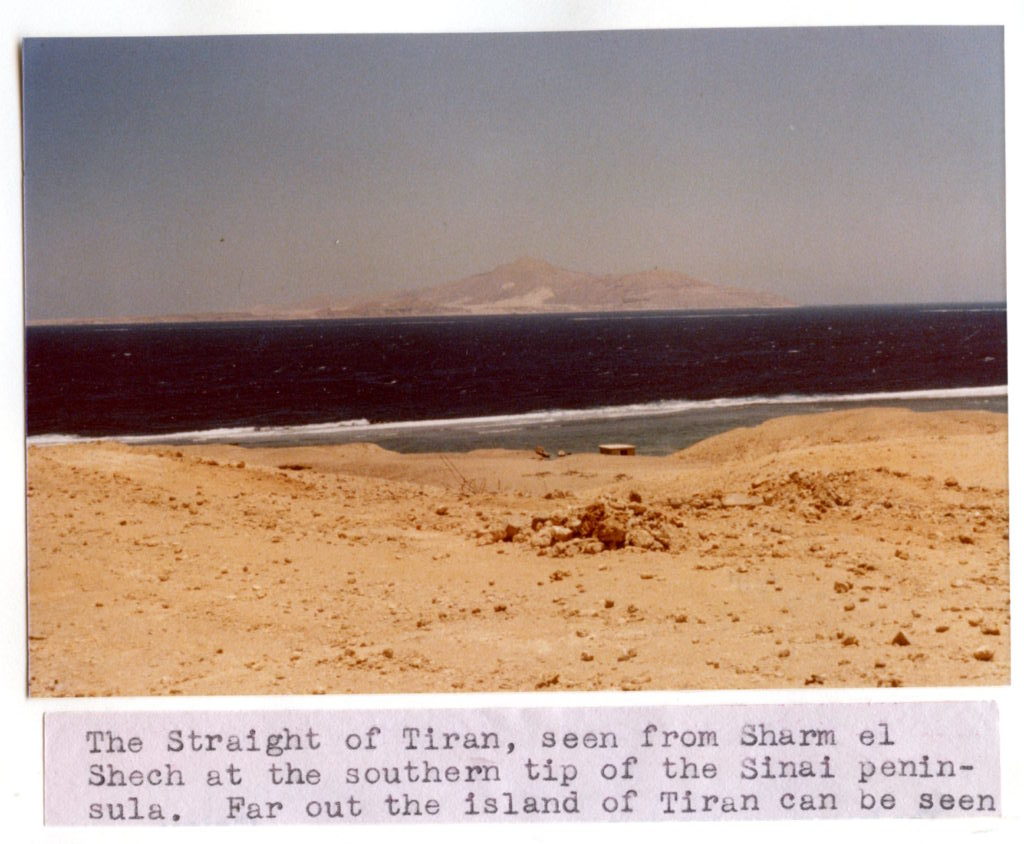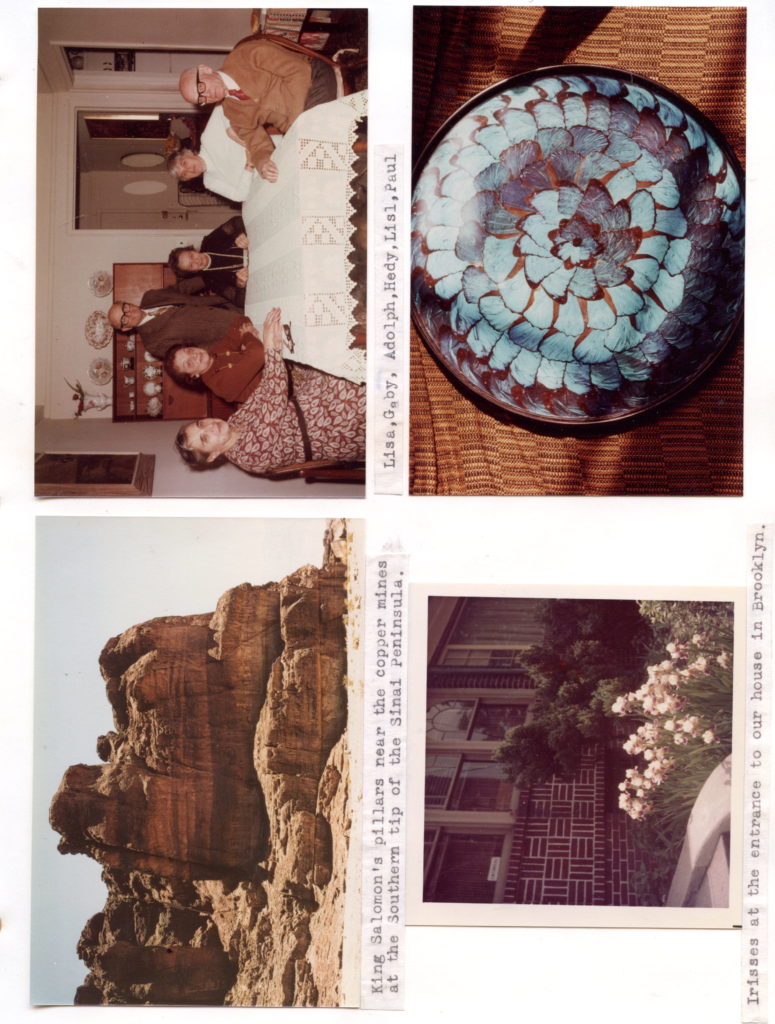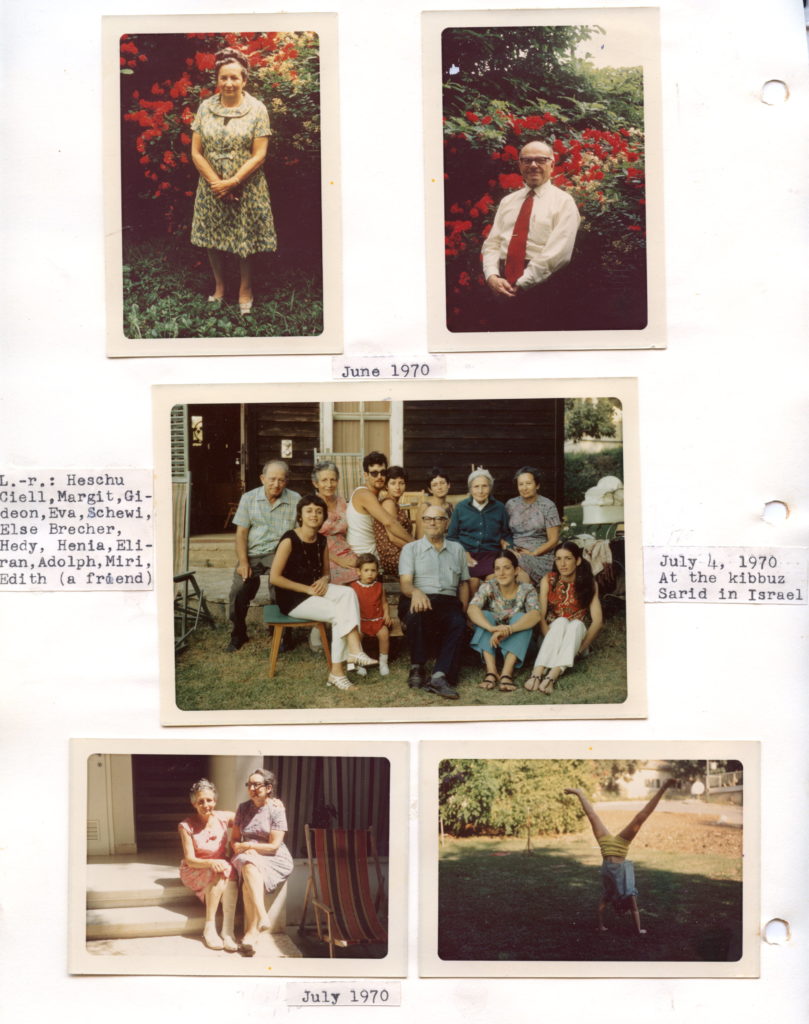1970
For the summer of 1970 we had planned a 6-weeks vacation, at first for 3 weeks to Israel and for 3 more weeks to Spain. For Israel it was an arranged tour, very well planned. For the first week we were stationed in Tel-Aviv and made from there different tours. One of the first was to the kibbuz Sarid in Galilea, where we were taken by Heschu Chiell by car. He was Margit’s husband, and we spent there two pleasant days with them and cousin Else Brecher, at that time over 80 years old, still very alert, but in general weak.
On another tour, we went by plane to Elath and from there to Scharm-el-Sheich at the southern tip of the Sinai peninsula, flying over Mount Sinai and circling it once. In Scharm-el-Scheich, a very hot place, we were taken by bus to a spot, where we could see the island of Tiran, separated from the mainland by the Strait of Tiran.
This is the spot, which caused the war of 1967, when president Nasser decided to send away a United Nations troop contingent, which was stationed there, to guard the entrance to the Gulf of Elath (also called Gulf of Aqaba). This meant a blockade of Israel, since it was the only outlet to the Indian Ocean, of enormous importance to Israel, since it received oil from Iran on that waterway, also exported goods to African and Asian countries through that strait. Israel could not accept that kind of strangulation. Nasser not only blockaded Isreal, but also made big preparations for an invasion of Israel, together with Syria and Jordan, and said that the day had come now close, when the Israelis will be finished off, driven into the sea. Israel reacted fast, starting a preemptive war, invading the Sinai peninsula, destroying from the air all the Egyptian airports and planes and advancing to the Suez Canal, annihilating the Egyptian army and capturing weapons Egypt had received from Russia in enormous amounts and was preparing for the invasion, then attacking Syria and advancing north into the Golan Heights and also attacking Jordan and occupying the entire Westbank of the Jordan River. All that was done in the course of 7 days and was brought to a halt by an armistice.
Since then, vast territories, the entire Sinai Peninsula, the entire Westbank of the Jordan River, and a chunk of Syrian territory, the Golan Heights, are in Israeli hands. That is, why we could visit places like the southern tip of the Sinai peninsula, the entire city of Jerusalem, the Massada, the entire area of the Sea of Nazareth, etc.
Prom Scharm-el-Scheich we flew back to Elath, where we stayed over night in a hotel. We had the next day a nice swim in the Gulf of Elath, went also by glass-bottom-boat on a pleasant ride, saw the anemones and lots of fish which followed the boat. We were also taken by bus to the place, where there were in biblical times the copper-mines of King Salomon, also to a store, where they sold jewelry and beautiful things made from Malachite and Azurite, and I bought there a piece of Malachite, as big as a small fist, partially polished. Back to Tel-Aviv by plane. We were visited there almost daily by Mr. Zwi Levi, whom we knew for a long time, since he had visited us once in Brooklyn. He was the husband of Hanna, a niece of Margit Chiell, and they had two lovely children. They lived in Rishon Le Zion and we visited them there once, went also to the Weizmann Institute, where Zwi Levi was employed, was there in a high position and he delegated a man to show us the institute, and he took us to all the modern buildings, also to the small house where Chaim Weizmann had started, many years back. For those who don’t know it I have to mention that Chaim Weizmann was a scientist and Zionist leader, and the first president of Israel. He became famous, when the British prime minister Balfour wrote and handed to him the Balfour declaration, which pledged British support to the Zionist hope for a Jewish national home in Palestine. We also visited in Tel-Aviv Paul Rosegg’s brother and sister-in-law.
For the second week we were stationed in Jerusalem, were taken there on tours, to the most important spots, the Wailing Wall, the Omar-and Aksa-Mosques, to the Holy Sepulchre Church, through the old city and along the Via Dolorosa, the Hadassah Hospital, where we saw the Marc Chagall stained-glass windows depicting the twelve tribes, all that on different tours, also the Knesset, the Israel Museum, the Billy Rose Garden of Sculpture, the Shrine of the Book, housing the Dead Sea scrolls, the John Kennedy Memorial, etc. We were also taken to a number of old synagogues. One of the most memorable experiences was a visit to the Wailing Wall on a Friday evening, when hundreds or perhaps thousands of Jews convened for prayers, some young people also for singing and dancing in bigger groups.
Once we were visited by Zwi Levi and wife Hanna and the two children and they took us to an Arab restaurant for lunch.

From Jerusalem we went on a tour to the Massada, passing through Arad, went up there to the top. There was no cable car there yet and we had to walk up, which was not easy on a hot day.
Up there we were shown all the remains of the walled castle, built by King Herod the Great. From high up there we had a good view of the Dead Sea.
On one of the next days we were taken on a tour to Hebron and Jericho, also for a swim in the Dead Sea near Jericho, then along the Jordan River to the Sea of Galilee, also called Lake Tiberias, to the city Tiberias and to the ruins of Capernaum.
For the third week we were stationed in Haifa, from where we went first on an excursion to Safed, where my great-grandmother was born and where she died, as described on page 9 to 15 of this biography, also to Meron, where she went, riding on the back of a donkey, to pray on a special day, called Lag ba-Omer. We were also taken to a spot very close to the border of Lebanon for a look into that country. We were once picked up by Heschu from Haifa and taken to the kibbuz for the third visit there. We also visited in Haifa the Recanatis, daughter and son-in-law of Mr. and Mrs. Rozin, old patients of mine, and on the next day we were taken to the Technion for a tour of that institution. From Haifa we were also taken by bus to Acre and Caesarea, where we saw the amphitheater, built by King Herod the Great in the year 10 B.C., which had been excavated and restored for outdoor concerts. Caesarea was during the Roman occupation the largest city in Palestine. Parts of the fortifications and the aqueduct can still be seen.
We were then taken to Tel-Aviv along the shore, stopping for a meal in Netanya. Margit came, before we left, to visit us in Tel-Aviv and we went together to the glass museum to see Phoenician glass, also to a few more places. We also saw Zwi Levi and Hanna as well as the children again, before we left for Europe.
The most beautiful and memorable part of the trip to Israel were our three visits to the kibbuz Sarid, each time for 2 or 3 days. It was a pleasure to be together with these people, to participate in their routine activities, to see how they cared for Else Brecher, who was treated like a queen. Margit especially was devoted to her, took constantly care of her. And there were Hechsu Chiell, Margit’s husband, and their 5 children, 2 sons and 3 daughters, with their respective wives and husbands, and their many children, which were Else’s great-grandchildren. It was a happy bunch of people. The little children were kept during the day in the children-house, were taken late in the afternoon to their parents, to be a few hours with them, but had to be back in the children-house for the nights, where they were under the care of nurses. Interesting for us were the meals, where everything was well organized, with the young people helping with the dishes and serving the food, although it was mostly organized as self-service. The food was, as far as I remember, vegetarian and very good, and the vegetables from the own fields.
Each time we visited the kibbuz, Heschu picked us up, and brought us back, the first time to Tel-Aviv, the second time to Jerusalem, and the third time to Haifa. Margit and Heschu had visited the U.S. about 3 years ago and we were together with them one afternoon in New Jersey. Unfortunately, Heschu died 2 years ago, in a heart attack. He was a very fine man. I forgot to mention that Else Brecher had died also, a few years ago, shortly after we had seen her.



